

Complex Skeletons Might Be Older Than Anyone Thought.
Inclusive fitness. In evolutionary biology and evolutionary psychology, the inclusive fitness of an organism is judged by the number of offspring it has, how they support them, and how their offspring could support others.[1] Advocates of inclusive fitness theory say that an organism can improve its overall genetic success by altruistic social behavior.

From the gene's point of view, evolutionary success ultimately depends on leaving behind the maximum number of copies of itself in the population. Until 1964, it was generally believed that genes only achieved this by causing the individual to leave the maximum number of viable offspring. The self-domestication hypothesis: evolution of bonobo psychology is due to selection against aggression. <div class="msgBox" style="margin-top:10px;"><span class="errMsg"><div>JavaScript is disabled on your browser.

Please enable JavaScript to use all the features on this page. </div></span></div><br /> Review a Department of Evolutionary Anthropology and Center for Cognitive Neuroscience, Duke University, Durham, NC, U.S.A.b Department of Human Evolutionary Biology, Harvard University, Cambridge, MA, U.S.A. Received 13 June 2011, Revised 22 August 2011, Accepted 27 October 2011, Available online 20 January 2012 MS. number: ARV-11-00475. Why House Cats Generally Don't Care (About You) Kinja is in read-only mode.

Did Microbes Cause The Earth's Most Devastating Mass Extinction? A Comprehensive Guide to Dinosaur Feathers and Scales. Why Do Animals Adopt? 30,000-year-old giant virus 'comes back to life' An ancient virus has "come back to life" after lying dormant for at least 30,000 years, scientists say.

It was found frozen in a deep layer of the Siberian permafrost, but after it thawed it became infectious once again. The French scientists say the contagion poses no danger to humans or animals, but other viruses could be unleashed as the ground becomes exposed. The study is published in the Proceedings of the National Academy of Sciences (PNAS). Inventing Game of Life - Numberphile.
Endosymbiotic theory. The endosymbiotic theory states that several key organelles of eukaryotes originated as symbioses between separate single-celled organisms.
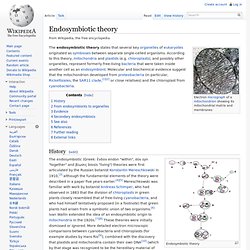
According to this theory, mitochondria and plastids (e.g. chloroplasts), and possibly other organelles, represent formerly free-living bacteria that were taken inside another cell as an endosymbiont. Molecular and biochemical evidence suggest that the mitochondrion developed from proteobacteria (in particular, Rickettsiales, the SAR11 clade,[1][2] or close relatives) and the chloroplast from cyanobacteria. History[edit] Endosymbiotic theory The endosymbiotic theory was advanced and substantiated with microbiological evidence by Lynn Margulis in a 1967 paper, On the origin of mitosing cells.[11] In her 1981 work Symbiosis in Cell Evolution she argued that eukaryotic cells originated as communities of interacting entities, including endosymbiotic spirochaetes that developed into eukaryotic flagella and cilia. From endosymbionts to organelles[edit] The Unique Merger That Made You (and Ewe, and Yew) - Issue 10: Mergers & Acquisitions.
At first glance, a tree could not be more different from the caterpillars that eat its leaves, the mushrooms sprouting from its bark, the grass growing by its trunk, or the humans canoodling under its shade.
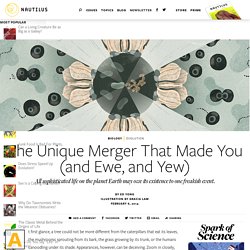
Appearances, however, can be deceiving. Zoom in closely, and you will see that these organisms are all surprisingly similar at a microscopic level. Specifically, they all consist of cells that share the same basic architecture. These cells contain a central nucleus—a command center that is stuffed with DNA and walled off by a membrane. Suspicious Virus Makes Rare Cross-Kingdom Leap From Plants to Honeybees. Tobacco ringspot virus extracted from honeybees.
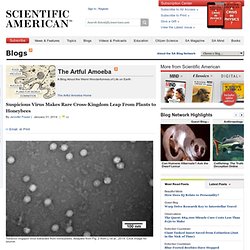
Adapted from Fig. 2 from Li et al., 2014. Click image for source. The world's oldest cancer is 11,000 years old. Hehe I only heard about it when looking into this cancer yesterday.
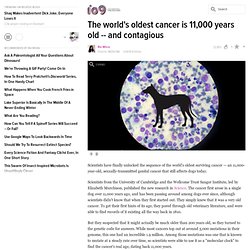
I just thought it was so random! I'm going to speak more generally about cancers, since that's what most of the research is on. This particular cancer is rare since it's growing in hosts it didn't arise from. Cancers (like viruses) are very mutable and therefore effective at countering our immune system. There are several main methods that have been described: Long Before Trees Overtook the Land, Earth Was Covered by Giant Mushrooms. Domesticated Dogs Most Likely Originated in Europe Nearly 19,000 Years Ago. Most people know that the dogs people keep today as pets came from wolves, but it hasn’t been entirely clear when humans first started domesticating them.
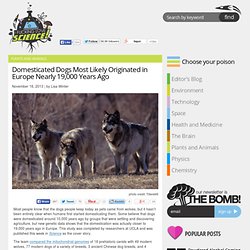
Some believe that dogs were domesticated around 10,000 years ago by groups that were settling and discovering agriculture, but new genetic data shows that the domestication was actually closer to 19,000 years ago in Europe. This study was completed by researchers at UCLA and was published this week in Science as the cover story. Genes without templates. Many genes are completely new inventions and not just modified copies of old genes March 25, 2013 It is easier to copy something than to develop something new - a principle that was long believed to also apply to the evolution of genes.

According to this, evolution copies existing genes and then adapts the copies to new tasks. However, scientists from the Max Planck Institute for Evolutionary Biology in Plön have now revealed that new genes often form from scratch. We have only discovered 14 percent of all species on Earth. Scientists have spent centuries trying to catalog all the different species on Earth, but according to a recent study, less than 15 percent of the 8.7 million species have been discovered. Yes, apparently 86 percent of the planet’s species are still unknown to us. More frightening than the thought of crazy alien-looking creatures going undiscovered at the bottom of our oceans is the thought that many of these mystery-creatures will fade out of existence before we can even document them at the rate species are becoming extinct right now.
According to the study’s co-author, Boris Worm of Canada’s Dalhousie University, the study was based on one question: “Are we within reach of finding all species, or are we way off?” New findings from UNC School of Medicine challenge assumptions about origins of life — News Room - UNC Health Care. September 13, 2013 Media Contact: Mark Derewicz, 919-966-9037, mark.derewicz@unch.unc.edu.
It's time to get skeptical about "the selfish gene" Sperm Wars Can Create New Species. A weird new insight into how new species evolve. Evolution is steered by aggressive competition between females. Earth's history to be rewritten. 26 September 2013 Oxygen Until now, science has believed that oxygen in the Earth's atmosphere has been around for roughly 2.3 billion years, or roughly half way back along our planet's 4.6 billion year timeline.
However, new research results provide evidence that the dating of a so-called “Great Oxygenation Event” needs a 700- million-year backwards recalibration. The dramatic results come from a project involving researchers from the University of Copenhagen (UCPH), the Nordic Center for Earth Evolution (nordCEE), the University of Southern Denmark and several other universities globally. The incredible discovery suggests that the history of life on Earth now includes a previously unrecognised chapter. Facebook. BoxCar2D. This is why scurvy is one of evolution's greatest mysteries. Dinosaurs Went Extinct Almost Immediately After Mexican Asteroid Strike. Why slime molds can solve mazes better than robots. Scientists make jaw dropping discovery › News in Science (ABC Science) News in Science Thursday, 26 September 2013 ABC/AFP. Timeline Photos. Why the world has to ignore ReptileEvolution.com. No Hope For Jurassic Park? Scientists Say DNA Is Too Fragile.
700,000-Year-Old Horse Found in Yukon Permafrost Yields Oldest DNA Ever Decoded. The frozen remains of a horse more than half a million years old have reluctantly given up their genetic secrets, providing scientists with the oldest DNA ever sequenced. Tuberculosis may have been stalking humanity for 70,000 years. Newly discovered “Pandoravirus" could redefine life as we know it. Subglacial Lake Vostok (Antarctica) Accretion Ice Contains a Diverse Set of Sequences from Aquatic, Marine and Sediment-Inhabiting Bacteria and Eukarya. 145-Million-Year-Old Seawater Found beneath Chesapeake Bay. A new study published in Nature provides chemical, isotopic and physical evidence that groundwater found more than 3,200 feet deep under the Chesapeake Bay is remnant water from the early Cretaceous North Atlantic Sea.
This map shows locations of Chesapeake Bay crater and coreholes; the black and red circular lines mark the outer edges of the inner and outer craters; the black circle marks the location of the deep corehole. Image credit: Sanford WE et al. Scientists discover the remnants of a 3.5 billion-year-old ecosystem. Deep microbes live long and slow. 28 August 2013Last updated at 06:52 ET By Simon Redfern Reporter, BBC News, Florence Viruses exist in rocks deep beneath the ocean floor all over the globe A diverse range of life forms exists deep below Earth's surface, scientists have concluded, but they survive at an incredibly slow pace. The bizarre life forms that cannot be categorized. New Giant Viruses Break Records. New life found on plastic waste gives rise to the 'plastisphere' Dolphins Call Each Other By Name. Bottlenose dolphins call out the specific names of loved ones when they become separated, a study finds.
Other than humans, the dolphins are the only animals known to do this, according to the study, published in the latest Proceedings of the Royal Society B. City birds use cigarette butts to smoke out parasites. National Geographic Magazine - NGM.com. By Evan Ratliff "Hello! How are you doing? " Animals can tell right from wrong. Whisper-like behavior in a non-human primate - Morrison - 2013 - Zoo Biology.